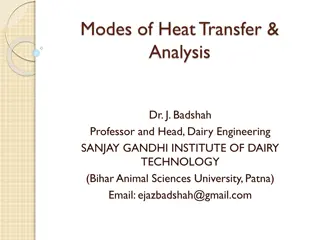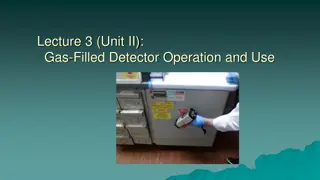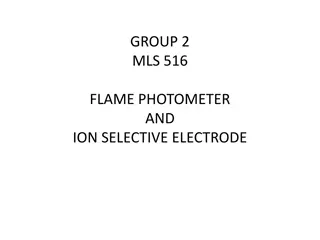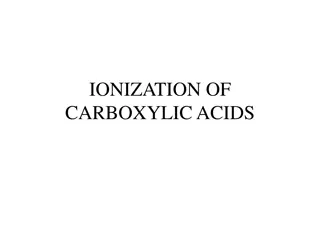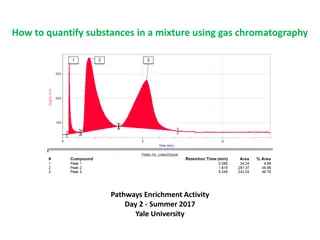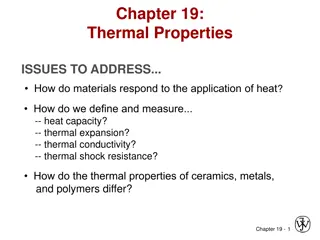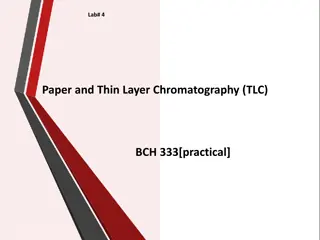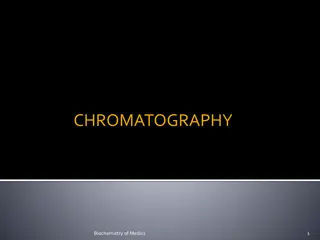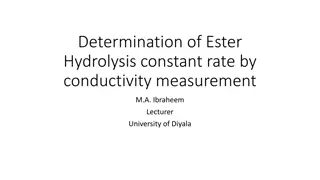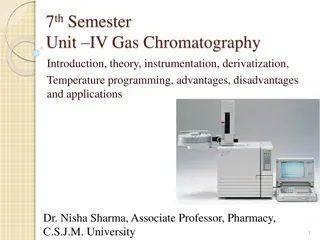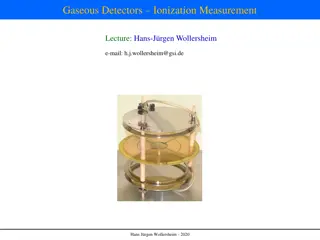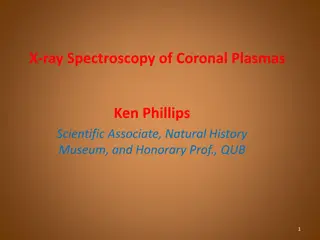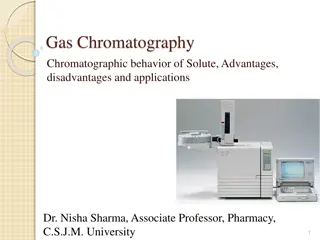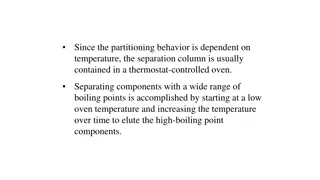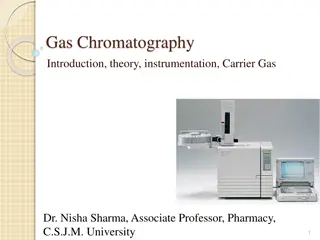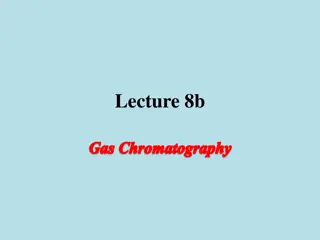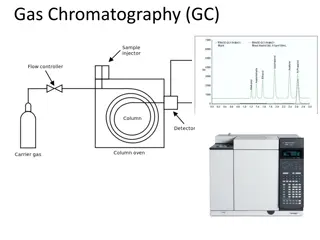Gas Chromatography Detectors: Flame Ionization and Thermal Conductivity
Gas chromatography detectors play a crucial role in separating and analyzing compounds in the pharmaceutical field. The Flame Ionization Detector (FID) utilizes hydrogen flame to ionize compounds eluted from the column, while the Thermal Conductivity Detector (TCD) principle involves converting electrical power to heat in a resistant filament. FID detects carbon-hydrogen groups with high sensitivity but is insensitive to non-combustible substances. On the other hand, TCD measures the heat power loss to analyze compounds based on their thermal conductivity.
Download Presentation

Please find below an Image/Link to download the presentation.
The content on the website is provided AS IS for your information and personal use only. It may not be sold, licensed, or shared on other websites without obtaining consent from the author.If you encounter any issues during the download, it is possible that the publisher has removed the file from their server.
You are allowed to download the files provided on this website for personal or commercial use, subject to the condition that they are used lawfully. All files are the property of their respective owners.
The content on the website is provided AS IS for your information and personal use only. It may not be sold, licensed, or shared on other websites without obtaining consent from the author.
E N D
Presentation Transcript
Gas Chromatography Detectors: Flame Ionization and Thermal Conductivity Detector Dr. Nisha Sharma, Associate Professor, Pharmacy, C.S.J.M. University 1
DETECTORS Flame Ionization Detector (Nanogram - ng) Temp. of H2 flame (H2+O2+N2) ionizes compds eluted from column into flame. Ions collected on collector electrode and recorded on recorder due to electric current. I=V/R Potential of 400 V across 2 electrode- lowers the resistance b/w electrodes & causes current to flow. Flame jet & collector position is 0.5- 1 cm above the tip of flame. Forms twin electrode 2
Current arises from the ions & free e-, generate in pure H2/air. When ionisable material from column effluent enters flame & burned, current rises abruptly. Current flows thru external resistor, sensed by voltage drop-amplified-sends output device recorder/ microprocessor. FID enclosed in chimney-heated sufficiently-to avoid conditions of H2O droplets-from combustion process. FID-responds- no. of CH2- grps. Introduced into flame. Eg. Response of equimolar amt. of butane is twice to ethane. No responses from fully oxidized C- carbonyl,-COOH gp. Ether grp. Response from C attached to OH, -NH grp. is If desired CO, CO2--- converted to CH4 by redn. with H over Ni cat.--- Measured 4
Flame Ionization Detector Column effluent is passed through a H2-Air flame Produces ions and electrons Charged particles are accelerated by voltage applied between jet and collector results in current Number of ions depends on number of reduced (methylene) carbons in molecule one molecule of ethane gives twice the signal of one molecule of methane less sensitive for non-hydrocarbon groups insensitive to H2O, CO2, SO2 and other noncombustibles Exhaust Chimney High sensitivity, low noise, destructive Collector Electrode Igniter Polarizing Electrode Column Effluent Hydrogen Inlet 5
Thermal Conductivity detector katharometer Leads to W.S. bridge Metal block Filament Reference Carrier gas Carrier gas out R sample s A heated filament is cooled by the flow of carrier gas . 6
Thermal Conductivity Detector Principle: Electrical power is converted to heat in a resistant filament and the temperature climbs until heat power loss from the filament equals the electrical power input. The filament may loose heat by radiation to a cooler surface and by conduction to the molecules coming into contact with it. The ability of a colliding molecule to carry off heat depends on its thermal conductivity. Hydrogen and helium have high thermal conductivity and therefore will be more efficient at cooling a heated filament than other gases will. 7
Thermal Conductivity Detector The detector contains two filaments: one exposed only to carrier gas, while the other is exposed to the carrier gas for sample analysis. When the gas for the sample analysis is only carrier gas , the two filaments can be balanced. Instead of a direct measurement of filament temperature, the filament resistance, which is a function of temperature, is measured. 8
Thermal Conductivity Detector Measures the changes of thermal conductivity due to the sample (mg). Sample can be recovered. Heated filament is placed on the emerging gas stream. Amount of heat lost from filament by conduction to the detector walls depends on the thermal conductivity of gas phase With in the cavity of metal block- coiled filament- Tunsten metal, Tungsten rhenium alloy, tungsten sheathed with gold. Filament is heated to constant temp. but less than dull red, regulated by DC current Loss from filament to metal block is constant, when only carrier gas flows Thermal conductivity of H & He is 6-10 times greater than organic compounds 9
Thermal Conductivity Detector Presence of small amount of organic material results in relatively large decrease in TC of column effluent. Filament retains max. heat & Temp. rises & electrical resistance increases Standard detector: 4 identical filaments, mounted in 1 brass block Filaments form arms of a wheatstone bridge Through one pair of filament column effluent is passed & 2nd pair is places in gas stream near sample injection port Any imbalance b/w pair of filaments are recorded 10
Thermal Conductivity Detector When analyte comes, Filament Temp. rises When compound elutes, T.C. of gas mixture of carrier gas & compound gas is decreased Filament in sample column becomes hotter than other control column Resistance increases and imbalance b/w control and sample filament resistance is measured Ability of colliding molecules to carry off heat depends upon its TC. H & He have high TC & more efficiently cools in heated filament conc. sensing detector 11
Thermal Conductivity Detector Responds to all compounds, simple construction, Good & Adequate sensitivity to many compounds Good linear range of signal Simple construction Signal quite stable provided carrier gas flow rate, block temperature, and filament power are controlled The TCD is a nondestructive, concentration sensing detector. 12
Thermal Conductivity Basics When the carrier gas is contaminated by sample , the cooling effect of the gas changes. The difference in cooling is used to generate the detector signal. Leads to W.S. bridge Metal block Filament Reference Carrier gas Carrier gas out R Flow Flow sample s A heated filament is cooled by the flow of carrier gas . 13


